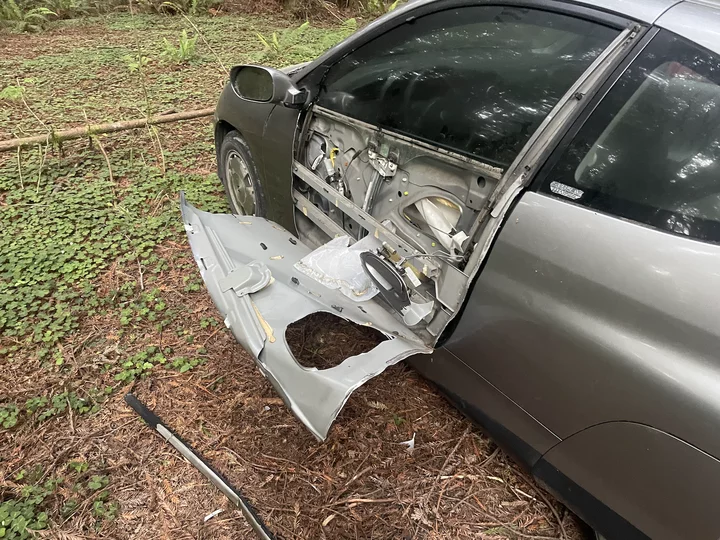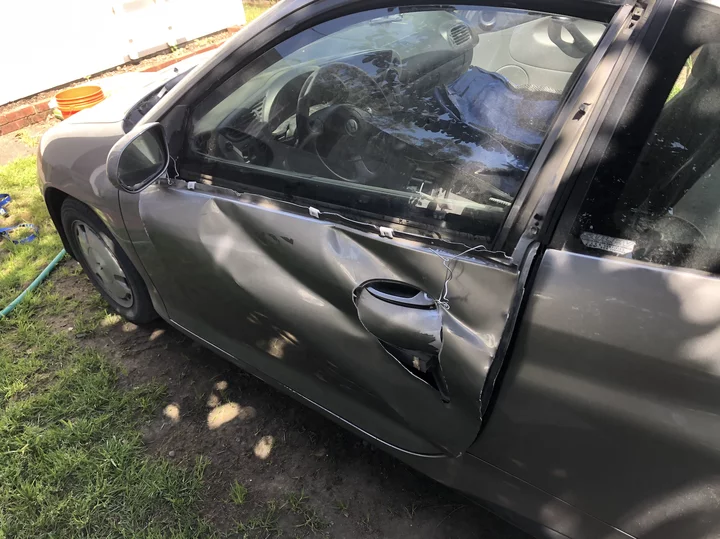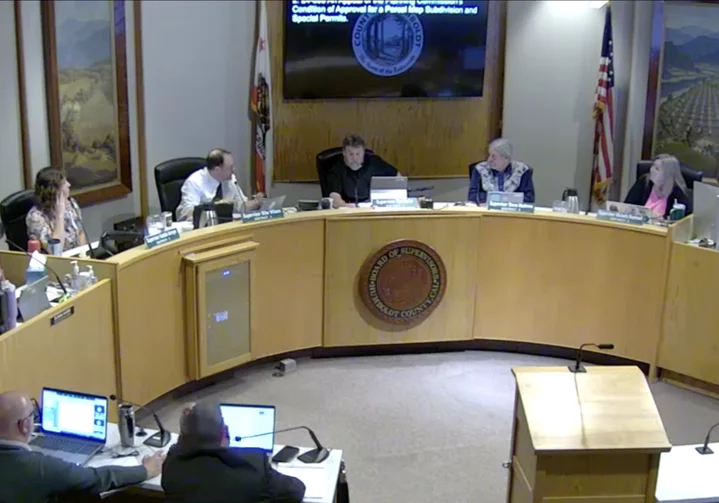A Bear Tried to Rip the Door Off My Boyfriend’s Car Near McKinleyville Last Night: A Poem
Jacquelyn Opalach / Wednesday, May 22, 2024 @ 1:46 p.m. / Animals
My boyfriend’s car this morning. | Jacquelyn Opalach
Today, I woke up to a text from my neighbor
Who heard a bump and scratch in the night, not too far
You see, a bear was expending great labor
To rip a hole into my boyfriend’s small car
She yelled and she clapped, the bear ran away
And although the great beast didn’t manage to enter
The damage was done: door bits scattered every which way
Luckily my dude is a nifty inventor
With a smile n’ pliers he hacked up a quick fix
Alas, in this rural tale no one wins
So a few words of caution to folks in the sticks:
Don’t leave an old pizza box on the seat of your rigs
Today, my boyfriend will give State Farm a ring
Hopefully they cover this sort of thing?
All fixed up, for now.
BOOKED
Today: 3 felonies, 10 misdemeanors, 0 infractions
JUDGED
Humboldt County Superior Court Calendar: Today
CHP REPORTS
0 Sr299 (HM office): Defective Traffic Signals
ELSEWHERE
RHBB: Driver Located After Vehicle Goes Down Embankment on Highway 1 South of Leggett
RHBB: SUV Plunges Down Embankment off Highway 199, Major Injuries Reported
County of Humboldt Meetings: Human Rights Commission Agenda - Hybrid Meeting
RHBB: Shoreline Grants from State Parks Invite Agencies to Seek Funding for Coastal Erosion Projects
Fortuna Teen’s Remains Found in Hoopa
LoCO Staff / Wednesday, May 22, 2024 @ 11:49 a.m. / News
Rodney Viveiros Dawson Jr.
PREVIOUSLY:
# # #
Humboldt County Sheriff’s Office press release:
The Humboldt County Coroner’s Office has positively identified human remains discovered in the Trinity River near Red Rock in Hoopa on May 18, 2024, as that of 19-year-old Rodney Joseph Viveiros Dawson Jr. (DOB 05/02/2004) of Fortuna.
Dawson was reported missing to the Humboldt County Sheriff’s Office on April 22 after being swept away in the Trinity River near Tish Tang Campground. Search teams were unable to locate Dawson during a multi-weeklong search and rescue operation in the area.
Dawson’s death has been ruled accidental, with the cause of death determined to be probable drowning.
The Humboldt County Sheriff’s Office extends our deepest sympathies to Rodney Dawson’s family during this difficult time.
[UPDATED] County Administrative Officer Thought Deputy DA’s Israeli Flag Might Inspire Angry Protesters to Storm the Courthouse
Ryan Burns / Wednesday, May 22, 2024 @ 11:41 a.m. / Activism , Local Government
UPDATE, 2:45 p.m.:
County Administrative Officer Elishia Hayes provided the following comment:
The concern remains regarding the display of the flag. However, to clarify, what was expressed in the email was not around violence but rather damage to the courthouse, similar to what had occurred at the college.
The County Administrative Office and Human Resources has provided significant resources and support to DA Eads to address the flag in the window of the courthouse.
Current county policies prohibit the display of unapproved materials in county facilities. As the elected official responsible for the office hosting the flag, inquiries around her intentions for its removal should be directed to DA Eads.
###
ADDENDUM, 9:45 a.m. May 23:
As commenters below noted (and upvoted), we should have included a link to the policy in question. Here it is.
The policy, which was adopted 33 years ago, says that while county employees have the right to participate in political activities on their own time, “No political activity whatsoever is to take place on County time or County premises.”
It’s also worth noting that the Outpost did ask District Attorney Stacey Eads via email on May 8 why Rees has been allowed to display the Israeli flag in his window, given this county policy. She offered replies to other questions in that email but did not respond to that one. Nor did she reply to a follow-up email asking why she couldn’t answer that question.
###
Original post:
Pro-Palestine protesters demonstrating outside the Humboldt County courthouse on April 30, just hours after a law enforcement broke up the campus protest and occupation at Cal Poly Humboldt. | File image.
PREVIOUSLY:
- Major Pro-Palestine Protests at Cal Poly Humboldt Provoke Massive Police Response; Protesters Occupy Siemens Hall; Reports of Violent Force Between Activists and Law Enforcement
- DA Says Pro-Israel Deputy Roger Rees Won’t Be Assigned to Cases Involving Cal Poly Humboldt Protesters
- (VIDEO) And Now Gaza Protesters Have Gathered Outside the Humboldt County Courthouse
###
Deputy District Attorney Roger Rees insists that the Israeli flag hanging in the window of his fourth-floor office at the county courthouse is in no way political. He said as much in a recent interview with the Outpost.
But an email we obtained through a Public Records Act request shows that the county administrative officer had serious concerns about that flag’s potential to provoke a violent response.
On the evening of April 30, just hours before more than 200 cops in riot gear descended on the campus of Cal Poly Humboldt to break up the pro-Palestine student protest/occupation there, CAO Elishia Hayes sent a worried email to Humboldt County Sheriff William Honsal and District Attorney Stacey Eads:
From: Hayes, Elishia
To: Eads, Stacey J; Honsal, William
Subject: Courthouse Security
Date: Monday, April 29, 2024 5:16:27 PMHello Sheriff Honsal and DA Eads,
It has come to my attention that convoys of law enforcement are en route to Humboldt County. I can only surmise that this is in an effort to provide support to CalPoly Humboldt (CPH). As you know, there is an Israeli flag hanging from a window on the 4th floor in Roger Rees’ office. I know you are both aware that this flag has created a stir amongst Palestinian supporters and has garnered media attention. I have concerns, that should arrests occur at CPH, other protestors may bring their activities to the courthouse and will be enticed to breach the Courthouse in an effort to remove that flag and/or do damage to the Courthouse as they have done at the college. If this should happen, is there a plan to protect the courthouse and the staff/public who utilize this facility?
Regards,
Elishia Haves
Humboldt County Administrative OfficerSent from my Verizon, Samsung Galaxy smartphone
As it turned out, protesters did bring their activities to the courthouse the following day, gathering on the sidewalk beneath the jail to chant, wave flags and hold signs as they awaited the release of their arrested comrades.
But if any of them felt enticed to storm the building and/or do damage, they managed to contain said urge. The protest proved entirely peaceful.
Rees, for his part, made the scene that day, as he often does when pro-Palestine protesters gather at the courthouse. He stood across the street from the assembled demonstrators, waving his ostensibly apolitical Israeli flag.
California Could Require Age Verification to Visit Porn Sites
Ryan Sabalow / Wednesday, May 22, 2024 @ 7 a.m. / Sacramento
Illustration: CalMatters.
Republican Assemblymember Juan Alanis, a former Stanislaus County sheriff’s sergeant, and San Ramon Democrat Rebecca Bauer-Kahan, a women’s rights advocate, may not have a lot in common.
But last week they stood on the floor of the California Assembly and persuaded their colleagues to advance legislation that would have California join a handful of conservative states in passing laws requiring pornography sites to verify the ages of visitors to ensure they’re adults.
“This bill is not about harming the adult entertainment industry or attacking those that work for it,” said Alanis, a former crimes-against-children detective. “This bill is simply about protecting children – and the harmful exposure to increasingly available and increasingly violent sexual material online.”
Bauer-Kahan, a leading women’s rights advocate in the Legislature, told her Assembly colleagues that research shows 40% of college-aged women have reported being choked during sexual encounters, something she said their partners learned from watching porn.
“We may think this is a purity issue, but it goes well beyond that,” she said. “It is about the safety of our children. It is about making sure that they learn healthy behaviors.”
Their arguments resonated. None of the 80 members of the Assembly voted against Alanis’s Assembly Bill 3080, though 15 were listed as not voting. As CalMatters reported, lawmakers regularly decline to vote to avoid going on record against a controversial bill.
Under the bill, porn sites would need to take “reasonable steps” to verify a user is an adult, such as using age-verification software or having the user provide the site a credit card or government-issued ID. The bill would require that any data collection would ensure the user’s anonymity and would not be used to create a record of the user’s online activity.
The bill now moves to the Senate. There, the Democrat-controlled chamber is likely to hear testimony from the same parents rights and church groups, free speech advocates and porn producers who testified last month before the Assembly’s judiciary and consumer protection and privacy committees.
Porn stars, conservative family groups orgs testify
Joseph Kohm, director of public policy at the Colorado-based Family Policy Alliance, told the Assembly Judiciary Committee last month that children regularly visit online porn sites featuring sexual violence and verbal degredation.
“And what this means is that they are learning about sexuality from a perspective that portrays sex as physical abuse,” Kohm told the committee.
Free speech advocates countered that if California enacted the bill, it would stifle the First Amendment rights of adult Californians to access online porn. Members of the porn industry also testified it would reduce traffic to their sites if the restrictions are enacted as they have been in other states.
“It’s a customer deterrent,” queer porn performer Jiz Lee told the judiciary committee. “And if it was enacted in California, where a lot of our subscribers are based, it would hurt our business.”
Alison Bowden, executive director of the Free Speech Coalition, a porn industry trade group, told the judiciary committee that less than 1% of pornsite users actually complete the age-verification process in states that have passed the requirement.
“What they do, according to our data, is hit the back button and find a site that doesn’t comply with the law,” she said.
Porn ID laws in other states
Arkansas, Mississippi, Montana, North Carolina, Texas, Utah, Virginia and Kentucky have adopted age-verification requirements for porn sites based on “model legislation” from the Center for Renewing America, a conservative activist group, according to the California bill’s legislative analysis. The organization’s website lists its motto as “For God. For Country. For Community.”
The bill’s legislative analysis noted that the online porn site Pornhub blocked users in those states after the age-verification requirements became law.
Last month, Democratic Arizona Gov. Katie Hobbs vetoed a similar bill.
Late last month, the U.S. Supreme Court declined to hear the Free Speech Coalition’s challenge to the Texas law, which had been upheld by a federal appellate court.
The laws are new, and some were immediately blocked from taking effect due to legal challenges, so there’s little public data about how effective they’ve been in preventing kids from accessing porn or the impact on web traffic to porn sites.

Assemblymember Rebecca Bauer-Kahan speaks in support of SCR 135, which would designate May 6, 2024 as California Holocaust Memorial Day on the Assembly floor at the state Capitol in Sacramento on April 29, 2024. Photo by Miguel Gutierrez Jr., CalMatters
The European Union in December passed its own age-verification law. Bauer-Kahan told the Assembly that California should follow those European countries’ lead.
“Europe, which has much stronger privacy laws than our country, has done this,” she said. “They have found a way to put the verification of your age on your phone. A token is sent to the website without your personally identifiable information, and then you, if you’re an adult, can access legal pornography.”

Assemblymember Juan Alanis speaks at a press conference before a swearing-in ceremony for newly elected Republican representatives at the state Capitol in Sacramento on Dec. 5, 2022. Photo by Rahul Lal, CalMatters
Alanis told the Assembly last week that his bill isn’t that different from how retailers have traditionally prevented children from accessing other types of adults-only products. His bill, he said, would include porn sites in the same California law that prevents children from purchasing products including tobacco, fireworks, spray paint and firearms.
“I believe that California requires its own tailored approach,” he said. “That’s why my team and I have worked … to craft a workable bill using an existing statute that California has long used to protect our children from other types of harm.”
###
The CalMatters Ideas Festival takes place June 5-6! Find out more and get your tickets at this link.
CalMatters.org is a nonprofit, nonpartisan media venture explaining California policies and politics.
OBITUARY: Herman William Bouler, 1943-2024
LoCO Staff / Wednesday, May 22, 2024 @ 6:56 a.m. / Obits
Herman William Bouler, aged 80, passed away on April 27, 2024, in McKinleyville. Born on August 30, 1943, in Chicago Heights, Illinois, Herman lived a life rich in passion, creativity, and generosity.
Herman graduated from Monrovia High School in 1961 and shortly thereafter joined the Air Force, serving his country from 1961 to 1967. After his service, he moved to Humboldt County, where he embraced a life filled with peace, love, and artistic expression. His career at Pacific Gas & Electric was marked by dedication and a love for helping others.
Taking an early retirement from PG&E, Herman pursued his longstanding dream of becoming a pilot, ultimately becoming a flight instructor. Later, he returned to PG&E as a gas service representative, a role that allowed his joy of helping those in need to flourish. It was during this period that his photography began to thrive, as his work took him to the stunning corners of Humboldt, Shasta, Mendocino, and Sonoma Counties. His appreciation for the majestic beauty of everyday life in Northern California found new expression through his lens.
Herman’s passions were flying, art, family and friends. His hobbies were as varied as they were numerous: fishing, golf, playing music on the clarinet and harmonica, and avidly supporting the San Francisco Giants and Golden State Warriors. His explorative spirit led him to embrace multiple creative mediums, including pottery, painting, woodworking, drawing, photography, and carving.
The creation of his dream workspace with his beloved son marked a pinnacle in Herman’s life, offering a space where creativity thrived. This live-work space in Humboldt County became a testament to his artistic journey and commitment to living in the process of creation.
A proud member of the Humboldt County community, Herman was involved in numerous groups and associations, including the Redwood Art Association, Freemasonry, NAACP, Bill W., United States Coast Guard Auxiliary, Humboldt County Civil Grand Jury, (B)Men, and Eastern Star. His legacy of kindness, creativity, and explorative spirit will continue to inspire all who knew him.
Herman is preceded in death by his loving parents, Herman D. and Mattie M. Bouler. He leaves behind cherished memories with his son Virgil, grandchildren Cassius and Kaia, numerous cousins in the Chicago, Winter Garden, Florida, and Los Angeles areas, and many dear and special friends in Humboldt County and beyond whom he loved so dearly.
A Masonic Funeral Service will be held in his honor at Six Rivers Masonic Lodge, 251 Bayside Rd, Arcata, CA 95521, on June 1, 2024, at 2 p.m. Herman’s light will continue to shine, reminding us to savor each moment and follow our dreams with endless enthusiasm.
###
The obituary above was submitted on behalf of Herman Bouler’s loved ones. The Lost Coast Outpost runs obituaries of Humboldt County residents at no charge. See guidelines here.
Measles Update: The County Has Identified Everyone Who Was Exposed Earlier This Month; No New Cases to Report
Jacquelyn Opalach / Tuesday, May 21, 2024 @ 5 p.m. / Health
During a press conference today, Humboldt County Health Officer Doctor Candy Stockton said there are no new local cases of measles.
As of today, the Humboldt County Department of Health and Human Services (DHHS) finished contact tracing all 115 people who were potentially exposed to the disease on May 10, when someone with measles visited the Days Inn and St. Joseph Hospital emergency room in Eureka. It is believed that the infected person has left Humboldt County.
Those exposed aren’t in the clear yet, as symptoms could appear until May 31, Stockton clarified. DHHS is monitoring those individuals and is working with local healthcare facilities to spot measles symptoms should an infected person show up.
That said, most who were exposed are probably immune, which DHHS determined through interviews, vaccine records and some immunity testing. The vast majority are over the age of 30, and fewer than five are minors, Stockton said. Most of the 115 exposures happened at the hospital, and nearly half of the total exposures are health care workers.
“We’re very fortunate that most of those individuals who were exposed were over the age of 30, which is before a lot of the anti MMR [measles, mumps and rubella] vaccine misinformation that’s circulating really started to come into play,” Stockton said.
Vaccination is an effective defense against measles, preventing cases in 97 percent of people exposed. DHHS does not have immediate data on what percentage of Humboldt’s population is vaccinated for measles.
“It’s understandable that in this day and age, where many of us are not used to seeing these diseases, that the perceived risk of a vaccine can seem kind of scary. But the only reason we’re in this situation, where we can think the vaccine seems kind of scary, is because vaccines have been so effective at preventing these diseases. And so we no longer have pediatric hospital units full of children that are permanently damaged and/or dying from these vaccine-preventable illnesses,” Stockton said.
“I would love for us to learn from history and not have to learn from our own painful experience of watching our community members suffer from these diseases.”
Measles vaccines are typically administered to children in two doses, but adults who aren’t vaccinated or don’t know their status can get the jab as well.
Measles cases typically start with cold-like symptoms, which are followed by a red polka-dotted rash that usually starts at the top of the body and spreads downwards.
“At that point, you should call and check in with your healthcare provider to go through some questions over the phone to see if you might be at high risk and should be tested for measles or some other illness,” Stockton said.
“We ask that if you are developing symptoms that you think might be measles, please do not go into a healthcare facility unless you are so sick you need immediate medical support, because we don’t want to risk that spreading to other individuals – particularly in a healthcare setting – other individuals who might be immunocompromised and may not be able to fight off the virus if they’re exposed to it.”
If you think you might have measles but don’t have a healthcare provider, you can call DHHS at 707-268-2181 to get an over-the-phone screening.
“While I can never promise or guarantee that we won’t see cases, the odds are in our favor that this will not become an actual outbreak,” Stockton said. A measles outbreak is defined as three or more related cases.
TODAY in SUPES: Board Tweaks Rules on Tobacco Sales, and Amid Disagreement, a Majority Approves Letters of Support for New State Water Regs
Ryan Burns / Tuesday, May 21, 2024 @ 4:55 p.m. / Local Government
The Humboldt County Board of Supervisors. | Screenshot.
###
If you missed our earlier post, the Humboldt County Board of Supervisors started today’s meeting by passing a Middle East peace resolution that calls for an “immediate and permanent ceasefire” in the Middle East as well as “mutual exchange of all hostages” and “respect for international law.”
Other matters on the agenda hewed closer to home. For example, the board unanimously passed some amendments to its Tobacco Retailer Licensing Ordinance, a set of rules it adopted last summer.
Sofia Pereira, the county’s public health director, said that the Division of Environmental Health has now processed nearly all of the 57 applications it has received from retailers looking to sell tobacco products under the ordinance, and 51 of those retailers have already passed inspection.
When the ordinance was first being considered last year, Second District Supervisor Michelle Bushnell voiced concerns about the economic impacts to local businesses. She said she’d heard from several small business owners in her district who objected to a provision that said tobacco products couldn’t be displayed within five feet of candy, snacks or nonalcoholic beverages.
Today, the board nixed that language and replaced it with a requirement that tobacco products be placed either behind a counter or in a locked case.
“This amendment still aims to address youth access to tobacco products and retail outlets and is really consistent with how almost all of the stores are already set up,” Pereira said. “Only six out of the 57 retailers would need to make minor adjustments.”
The ordinance passed last year also enacted restrictions on coupons and discounts on tobacco products, and with today’s vote the board passed an amendment exempting cigars, loose-leaf tobacco and flavored shisha (or hookah) tobacco products from those restrictions.
Bushnell again advocated on behalf of cutting costs for local small business owners, saying the $500 price tag to apply for and obtain a tobacco retail license from the county is “a really big hardship” for some in her district.
Third District Supervisor Mike Wilson later countered that, while he understands the concerns about retailer expenses, there’s also a community cost that comes with nicotine addiction. If distributing nicotine, alcohol and other unhealthy products is the only thing keeping retailers afloat, he said, “maybe we need to figure out a way to subsidize stores to have good products for our community.”
Water legislation letters
Earlier in the meeting, the board engaged a mildly contentious discussion about whether or not to send letters of support for two pieces of pending state legislation: Assembly Bill 460, which concerns enforcement of existing water rights law, and Assembly Bill 1337, which concerns the ways in which the State Water Resources Control Board regulates flows and enforces state water rights.
The letters of support were brought forward for consideration by Fourth District Supervisor Natalie Arroyo and Fifth District Supervisor Steve Madrone.
The board discussed the two proposed letters separately, though First District Supervisor and Board Chair Rex Bohn wanted nothing to do with either of them and he made that apparent from the jump.
“I can’t support [the letters of support] in any way because, basically, the Farm Bureau opposes it; my dairymen … they’re pretty much opposed to it,” Bohn said. “We’re doing a pretty good job of driving agriculture out of California.”
Arroyo and Madrone defended AB 460 specifically, with Madrone saying it would raise fines for illegal water diversions, which harm endangered species and impact other water users, including fishermen.
Leaders from several local and regional environmental organizations called or Zoomed in, urging the board to approve the letters. One local cannabis farmer, Craig Johnson, called in to voice opposition, saying the legislation could harm local ag producers.
After the public comment period, Bushnell joined Bohn in saying she won’t support the letters. But those two supervisors were outnumbered by the board’s progressive majority, with Arroyo, Wilson and Madrone all voting to approve sending the letter in support of AB 460.
The conversation about AB 1337 was similar, though it delved into the history of allocating water rights in the state. The bill would, among other things, clarify that the State Water Resources Control Board has the authority to curtail pre-1914 water rights.
“I think this is a good bill,” Madrone said. “It tries to level the playing field, and it basically says that if there’s not enough water to go around, everybody ought to be treated equally.”
Arroyo said the bill is designed to address the over-allocation of water in California, and she noted that the letter addresses the matter of equity in water rights.
“Prior to 1914, Black people couldn’t have water rights,” she said. “A lot of Asian people … who were, you know, part of the agricultural community, could not secure water rights prior to 1914. And many tribes could not, either.”
Regular public commenter Kent Sawatzky threw some shade toward Bushnell and Bohn for their reticence, saying, “I find it more than a coincidence that people connected with a certain business known as cannabis would be the main ones opposing this.” He also noted that the motions being considered merely “authorize” the board chair to sign the letters, rather than requiring it.
After another round of public comment — during which many of the same folks called in urging support — Arroyo said it had never even occurred to her to question whether the chair (Bohn) might decline to execute his authority, so she asked him directly: “If the board passes these letters, do you intend to sign and send them, Supervisor Bohn?”
Clearly offended, Bohn remarked that this is his third time around serving as chair, and if the majority of his colleagues ask him to sign a letter he would never refuse to do so. “It shouldn’t even be asked,” he said regarding Arroyo’s question.
Again, the vote was 3-2 in support, with Bohn and Bushnell voting “no.”
Following a closed session period and a break for lunch, Sawatzky called in to comment yet again, ostensibly about a resolution proclaiming May “Older Americans Month,” though he quickly turned to the tense exchange between Arroyo and Bohn.
Sawatzky accused Bohn of being “arrogant, ignorant and rude,” and he apologized to Arroyo on behalf of “old people.” He was in the midst of saying something about how Madrone ensured better decorum during his turn as chair when Bohn interrupted, saying it didn’t sound like Sawatzky was addressing the matter under discussion.
“Rex,” Sawatzky replied, “will you please quit interrupting me?”
“Probably not,” Bohn said.
Sawatzky admonished him again to stop interrupting, and as he continued to speak, Bohn apparently cut him off, muting the line on which he’d called in.
“I’ll catch hell for that,” Bohn remarked.
Someone else could be heard saying, “What — .”
“I don’t know what he’s talking about,” Bohn said.
After another moment or two, the clerk of the board un-muted the line and Sawatzky finished his comments, saying hopefully he won’t be interrupted the next time.
What else happened?
Glad you asked.
- The board had a prolonged discussion about whether or not to uphold a ruling from the Planning Commission requiring McKinleyville property owner Robert Sutter to construct a curb, gutter and sidewalk in order to complete a minor subdivision development. After discussing a variety of issues, including cost concerns, objections from neighbors and pedestrian safety, the board opted to require a separated asphalt walkway and cable fence as a condition for the Sutter Ranch Subdivision. Sutter deemed this a less onerous requirement than the sidewalk.
- The board approved a request to convert the 2,800-acre Marshall Ranch, located just south of Briceland, into an agricultural reserve.
- As alluded to above, the board proclaimed May as “Older Americans Month” and heard an update one the Area 1 Agency on Aging from its director, Maggie Kraft. She said the state is proposing cutting $111 million in funding for senior meal programs, which would amount to $850,000 in cuts for programs on the North Coast over the next three years. “That’s a lot of meals in our area,” Kraft said.
- Jade Hoff, the county’s Childcare Sustainability Program manager, delivered an update on the Childcare Stabilization Fund, which was financed via the American Rescue Plan Act (ARPA).








